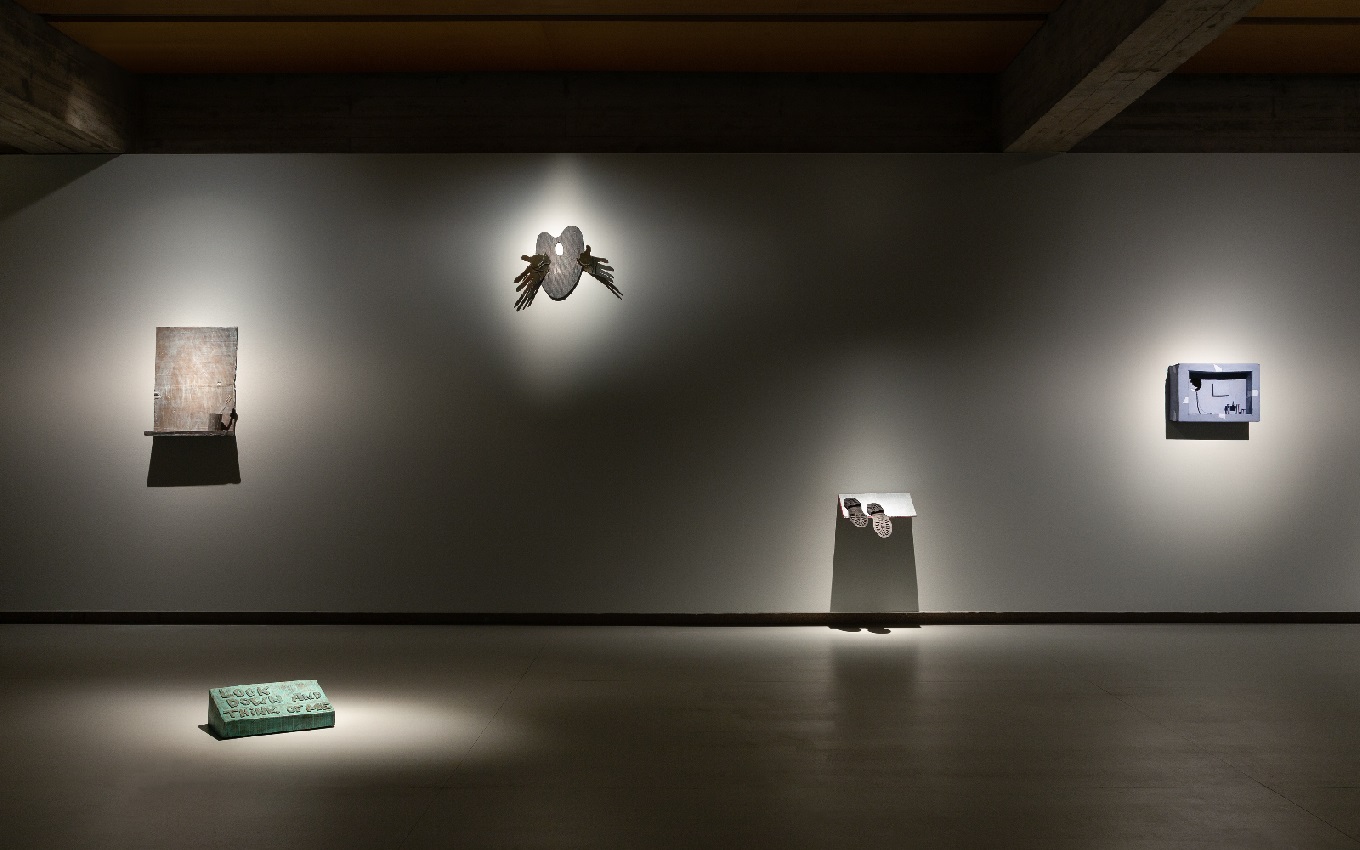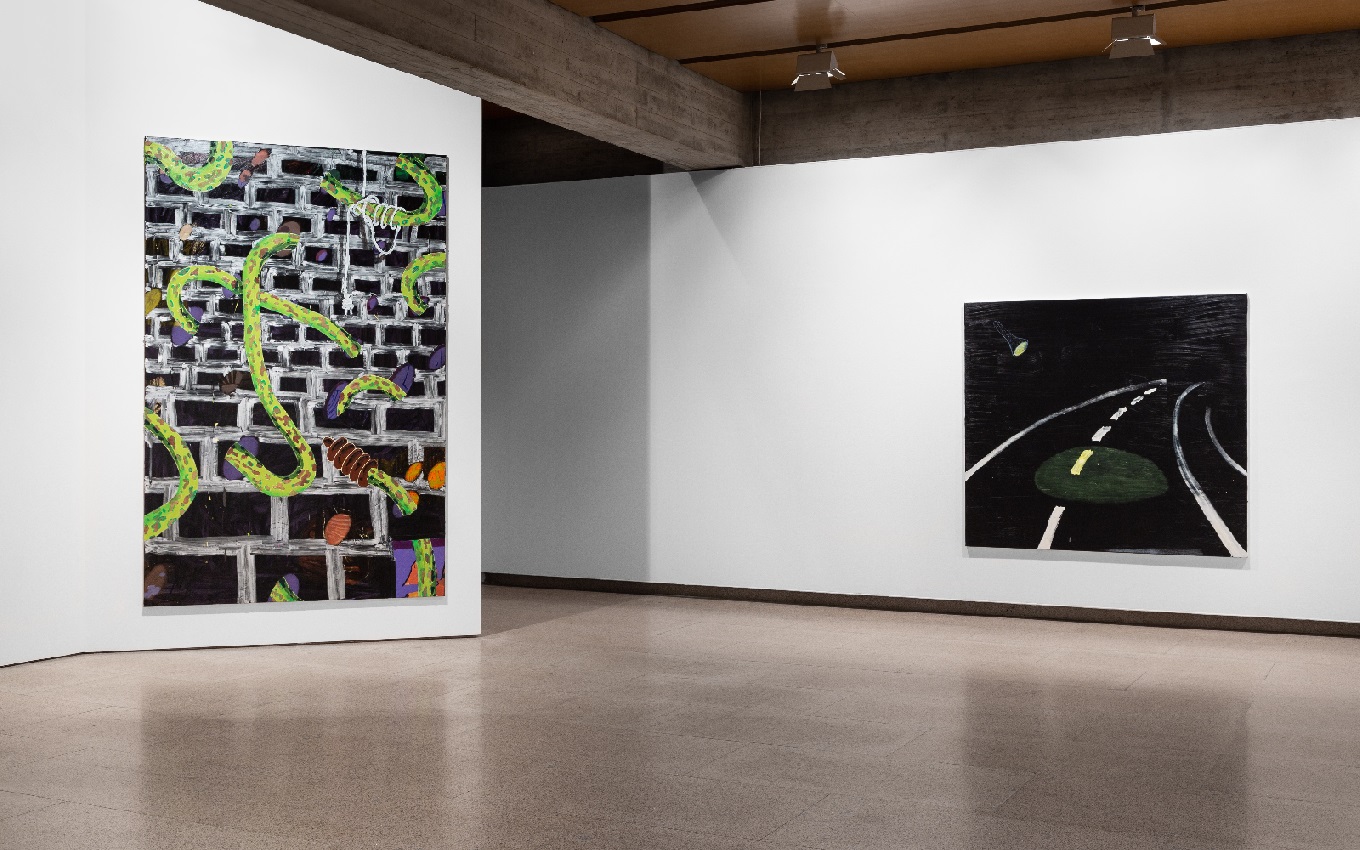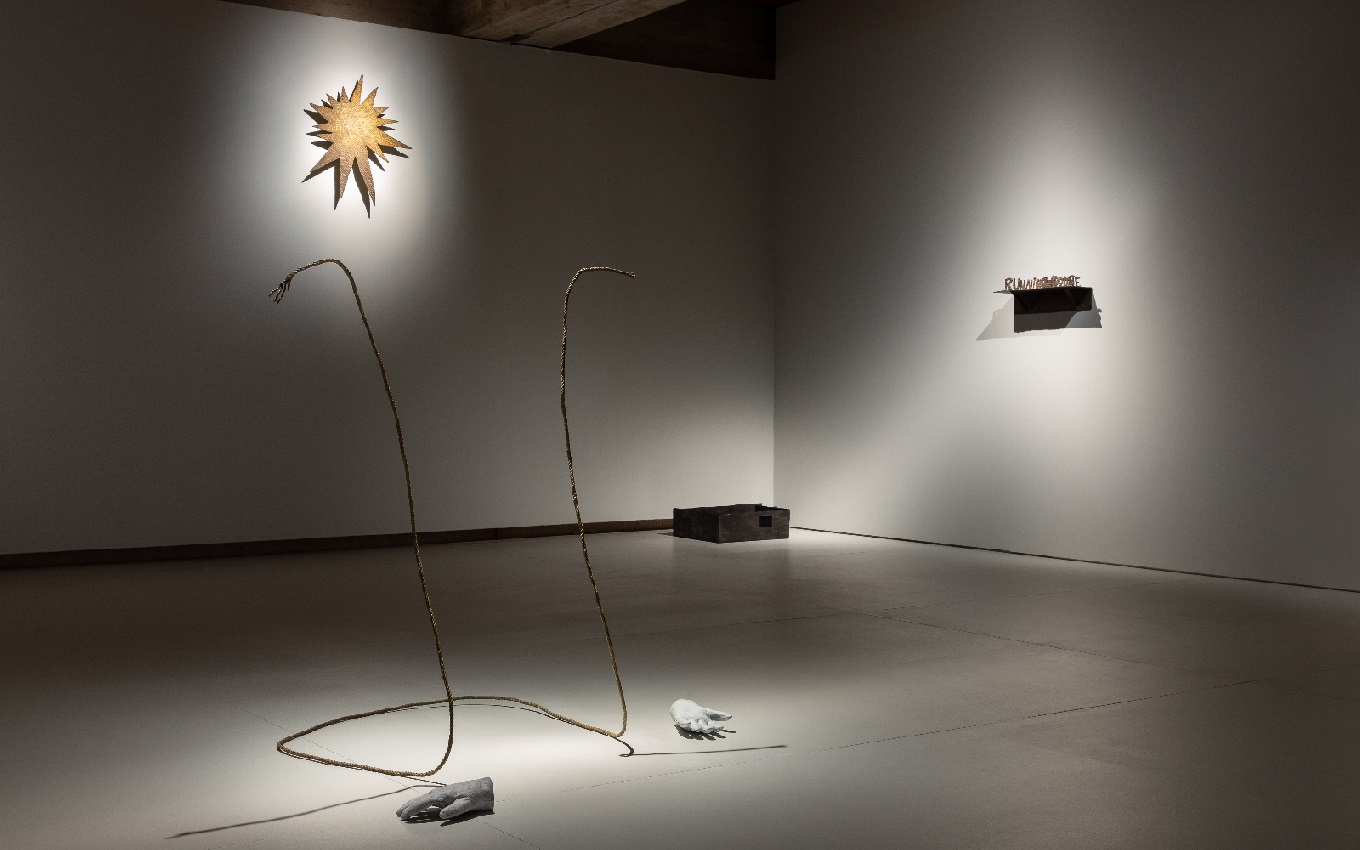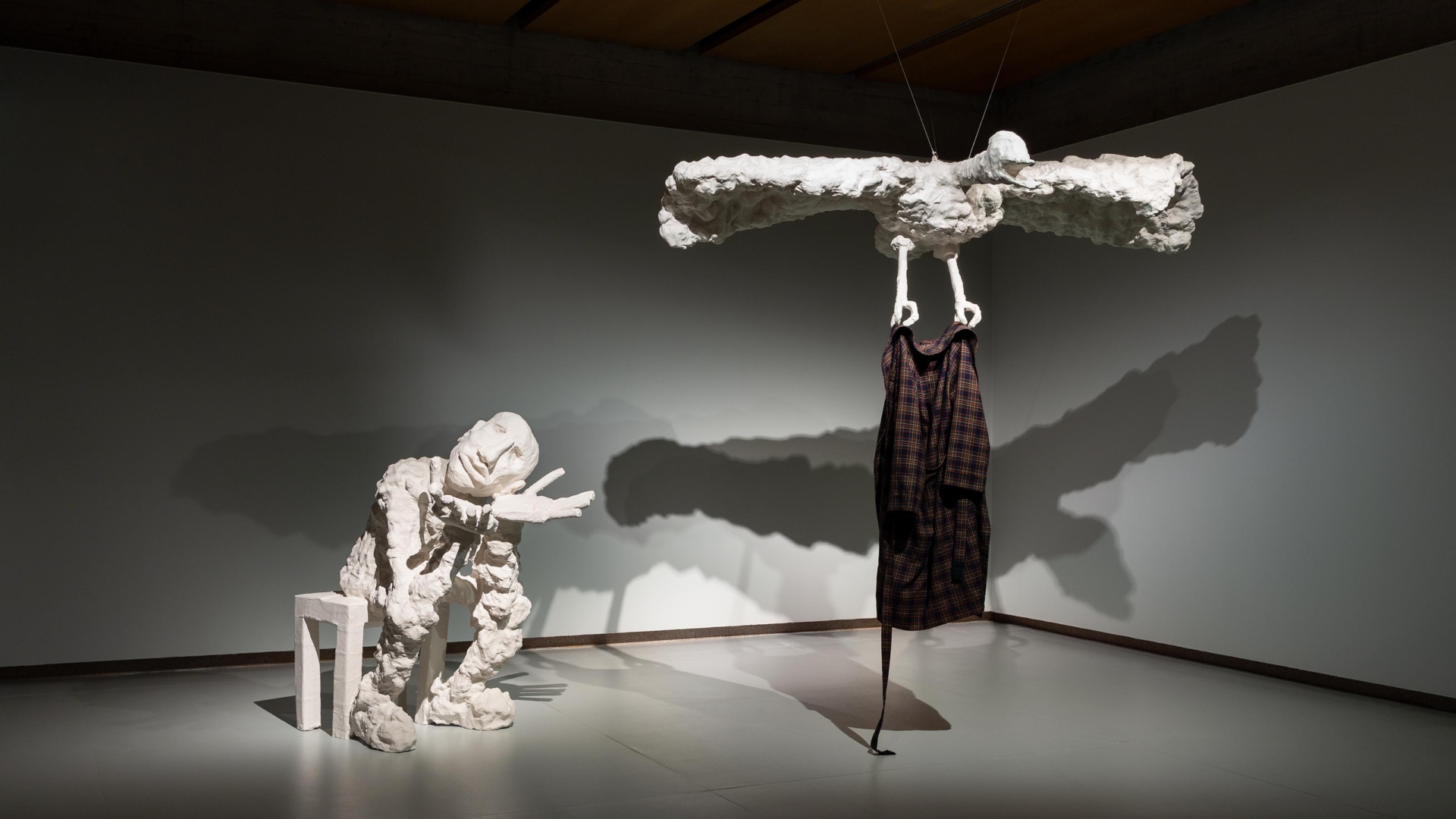The body always speaks first
Biting Dust is a staging place for transformation. Ever since I began thinking about this exhibition, I have been constantly reminded of secret passages, tunnels, safe havens or places free from attack, vaults that harbour characters, emptiness and clues about and for the absurd. The idea of building the corridor to divide the room homogeneously was a response to this very thing: the desire to simulate a secret passage dividing a place of contemplation from another that evokes falling into a bottomless well. No one bites dust, only after their final moment of life. Could that be a moment exclusively experienced by the one who ceases to be present? I can’t help associating this falling body that sinks its teeth into the earth with speculative archaeology. The exhibition has three moments, it’s a trio, united by the examination of what is experienced. The works are all siblings that don’t speak amongst themselves, but which know of and are aware of each other’s existence.

My attitude is almost like an archaeologist’s in terms of my predisposition to make these paintings and sculptures, and that is what links them. My approach to two- or three-dimensional work is no more than a different materialisation of the same universe, with intentions that are viscerally identical, often only understood after they are made. Whilst in painting there is no pre-defined image, perhaps because that would be self-sabotage of the very experience of painting, in these bronze sculptures I work from the negative, because they are made through direct burning of the original objects – in other words, there’s no mould.
Unlike an archaeologist who digs to find, who removes soil in order to see and touch what they are in search of, the group of paintings presented in the exhibition was made as the antithesis of that idea of subtraction: paint is applied in successive additions, as a vehicle to augment, to sculpt and draw on the canvas, fuelled by the same desire with which the archaeologist moves soil to find tangible remains.
Transforming a perishable material like cardboard, which disintegrates easily and quickly, into a metal – bronze – reveals the inclination to build a work that deceives the eye, but which stands firm, cynical, with an immense and fatal weight. It stops being paper and becomes an attempt at eternity. The density of the material is an integral part of its body, of what defines it. In the midst of the transformation process, the sculptures cease to exist. In other words, there is a sarcophagus that covers the cardboard, a ceramic husk that holds the void it leaves, into which liquid bronze is injected. Later, the cast sculpture must be excavated until it is found with all its errors enhanced. Any impression on the surface gains an unpredictable level of importance. There is a direct link here to the modus operandi of those who excavate.

Fighting against a canvas, which stands vertically in opposition to my body, means trying to defeat it with the awareness that I always lose for the better: the experience in itself. Like any animate being, the paintings are therefore left with scars, skins and the memory of the various paintings that lie behind the image and the matter that is petrified in the final layer. Can a painting ever be finished? Bonnard thought not, finding distractions in museums to help him continually touch up his works. If you say paintings, you mean work, you mean a living organism in constant change. Because the change of the variable is the only certainty.

In contrast to this archaeological metaphor, all the work presented in the exhibition reveals a deafening absence of the body: of the one that hides or that wants to be found. In the paintings Way back home (2021) and Balance, strength. Closed eyes (2021) the limbs are there, while the body itself is missing. This is also the case with Curious eye (2021), which hides and peeks from behind a space or galaxy. These limbs, in other words, part of a whole, are given an unmistakeable place of their own here: almost as if they had autonomy of action, as though they were the brain.
The sculpture Skeleton without purpose (2021) is made from a skipping rope and a pair of gloves, transformed into bronze. I imagine that the body that once used that rope has de-materialised, disintegrated, while the rope remains tense, turned by the weight of these gloves – a second skin, or a remnant of the body. These pieces evoke a permanent bereavement. A struggle for the will to persist.

There is also the construction of safe places, hideaways in the form of models. I see the sculptures Hideout (2020) and Life imprisonment (2021) as a transposition of the sense of place I attach to home or the studio/mental workspace. No player inhabits them. They are like a fall interrupted, of the user themselves, although there are indications that the spaces are lived in, such as a bottle, a bench or a table, a jumper or an easel. I’m talking about this loop of transformation, a physical place that replaces psychoanalysis through lack of assumptions.
The division [of the room] is implicit in all we experience. Here, the movement from one place to the other is cold, uncomfortable. The clock in Beginning (2019) stops time at 1.25pm, freezing it like a codex for the comprehension of a multiplication. Time stops too in Falling on stage (2021), when the blighted figure is left hanging in the air. This body that never asked to be born and which will inevitably fall onto a stage without an audience. What option is there other than to act anyway? In any case, there is a spotlight for no one in Next step (2021), in which a floating torch directs its light at the next step on an endless highway.

The chair and the bench behind two walls in The eternal monologue (2021), one of painted bricks and the other pure grey paint, are in infinite therapy. A silent therapy. It is obvious that the two or three post-its painted in thick yellow paint refer to this voyeuristic act, in which the commander takes useless notes. Perhaps there is a direct relationship with the passageway or corridor in the exhibition. Or at least with the hybrid length it can assume in different contexts. When you come out at the end of the passage, the rug Tombstone. Request (2019), a tombstone for the universal unknown, leads filthy feet and shoes to be cleaned on its inscription ‘LOOK DOWN AND THINK OF ME,’ demanding the gaze, thought and wretched charity of those who pass.

An arrow, Martyr (2019), diverted from its route into someone’s body, ends up displayed on a shelf. Next to it is Acceptance. Farewell (2020), which, unlike Skeleton without purpose (2021), gives space to a sitting body that is being undressed or left unprotected by this bird that is taking its dressing gown far away. The figure accepts that there is nothing to be done. These two figures are made from cardboard and foam covered in plaster. The dressing gown was once worn by a real person, as was the pair of gloves in bronze. It is a soft exoskeleton of the whole body evoked in the exhibition. It is not by chance that the snake in Vault (2021), whose head we never see, is entering into the other side, perforating a wall, imaginary in itself, but real in the exhibition space: it comes out of the first into the second room, losing and changing its skin in the twilight zone.


